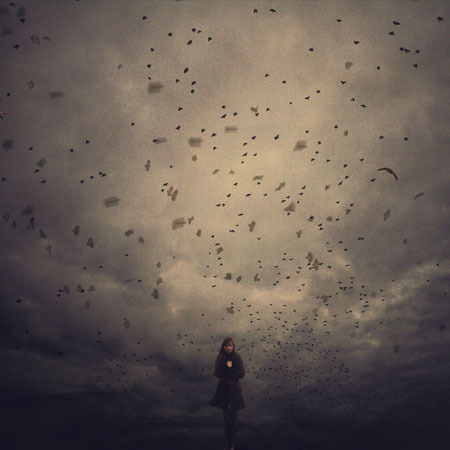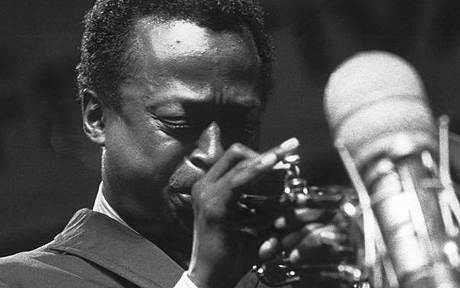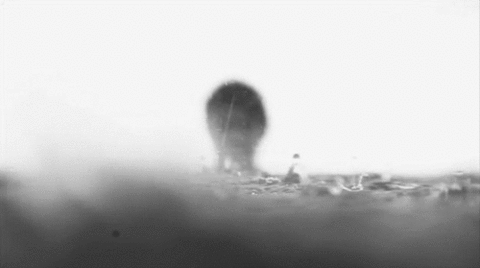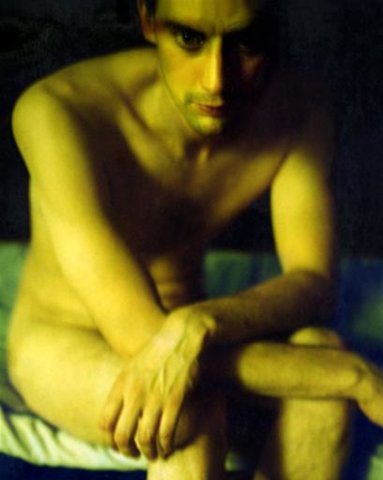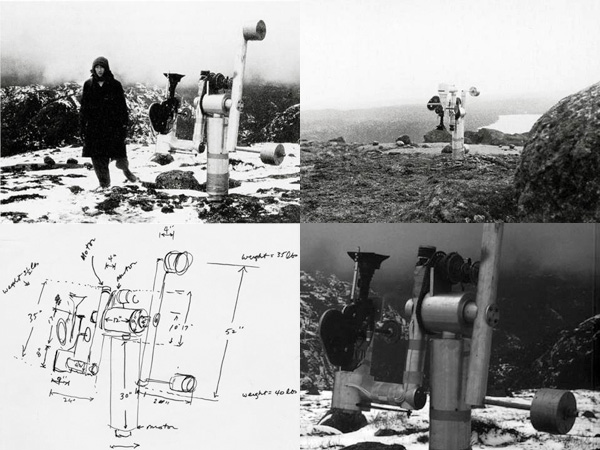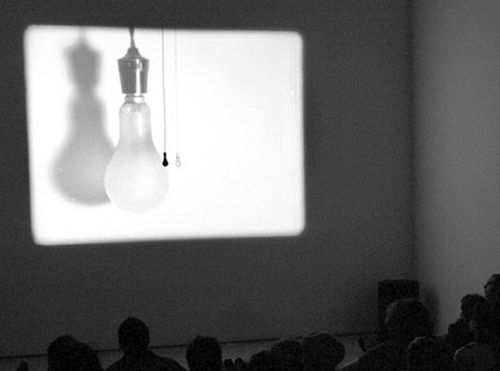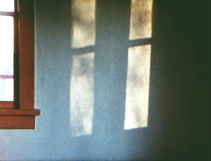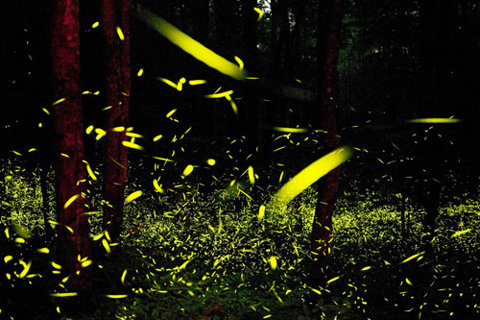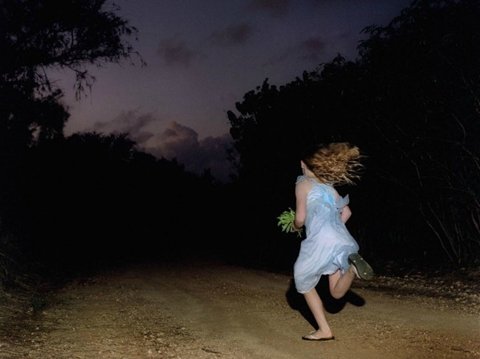Chase: How much of your method can be described as a (never-ending) quest to make “that film?” The one that tells it, the one that shows it, the one that makes it make sense to you, or perhaps to other people?
Mike: What I hear you asking is: how can you set out on a trip making sure never to arrive? Let’s hope it’s a bon voyage because we’ll never stop making it. If artmaking is a “never ending quest,” as you describe, perhaps part of the hope in setting off on the journey is that it never finds home. It makes me wonder if making movies is another way of leaving home, again and again, caught in the perpetual wave of departure. Starting another project may be a form of saying good-bye, setting off for another journey without end. Never mind the GPS or the insatiable desire to map every geographical moment (our colonizers have returned as computer geeks), never arriving means always being a little bit lost. Doesn’t it? If I weren’t lost more than occasionally in the work’s making, wouldn’t I arrive at The End with speed and efficiency. I think this is what Picasso meant when he said, “I don’t search, I find.” In Godard’s Prenom Carmen (1982), Godard answers this quip, playing a doddering, lecherous filmmaker offering advice to his niece who is trying to use his potential film comeback as a smokescreen for a bank robbery. He states simply, “Il faut que chercher.” One must search. The necessity of searching, of asking questions that do not resolve tidily into answers, might be necessary cargo in a voyage that doesn’t end. How can one search if one isn’t lost? If one must search, then there might also be an injunction to get lost, like in the old schoolyard expression: get lost! Can you be a little bit lost or is it an either/or proposition? You can’t die a little bit, you can’t be a little bit of a son. But if this artist is interested, as you suggest, in going on and on, in a chase scene attached to an object that will never arrive, then it’s important I guess not to arrive too early, or not to arrive at all.
“Freud’s sublimation theory is about an ongoing activity rather than a finished product, and it implies that there are many artists busy not finishing works of art. It is significant here to remember that Freud’s real interest in the study of Leonardo was in exactly this question of completion, of finishing things. Whether Leonardo’s works were actually finished or not is less important for Freud than the artist’s feeling that he had left something unfinished.” [i]
Astrologer
Several years ago, my astrologer informed me in no uncertain tones that in the next couple of years I would make the defining work of my career. In your words: “that film.” It would be the movie that everyone would think of when they heard my name. Did I say everyone? I mean of course the dozen or so artistes similarly engaged with these fringe emulsions and digital rarities. She assured me that I had two years to work on “my structure,” which was another way of saying my life, or sensitivities, or artist chops. It was as if the mold would harden and freeze in two years, and forever after I would be left with a rather too reliable mechanism. “And then?” I couldn’t help asking her. This is the problem with the future. You are offered a morsel and then you want to make a meal of it. A meal that never ends. “And then for seven years you’ll pick the fruit,” she replied, without a note of hesitation. It was her confidence that proved most unsettling. When I told her I didn’t speak the language of fruit she was glad to elaborate. “Picking the fruit” meant that after the trees had bloomed, I was free to sample whatever was in reach. Go ahead, take as much as you like. Only the trees would not bloom again. Try as I might, I could not resist asking the same question again. “And then?” She could not hide her disappointment, as if I already knew the answer I was forcing her to say out loud. “And then there’s a steady decline.” “Until I die?” “Yes, until you die.”
So there it was. The good news was that I was only two years away from my defining moment, the mega hit certain to ride the top of the avant charts. The almost good news was that I could coast on whatever gains I could manage for another seven years after that. And the fatal message was that I was done as an artist, I had nothing left to say and no means remained to say it. How many five star bands knocked out late night pop hits when they were hardly old enough to shave? Only to find the knack had completely abandoned them after just a few short years of excess. I thought that those of us who plied the margins were granted a permanent relief pass from these obstacles, for one thing, there’s not so far to fall when there’s not so high to climb. And if these motion picture confections were neither art world consumable or part of the horizon of real movie makers, our double bind offered us immunity from the slings and arrows of outraged publics, popularity contests, markets and buyers, fair and unfair trades. Then the home computer shrank edit machines and sound studios to the size of a computer chip, and everyone’s phone became a movie camera. What had been the exclusive providence of a handful of dedicated, speechless, bottom dwellers were now casual mom and pop throwaways. Just wait here honey while I toss off another avant-garde movie. Who isn’t a video artist now? But wait, how did the prophecy play out? How does one engage in a practice that is predicated upon “that film” never arriving, so that the practice can continue to reshape itself, only to be stonewalled by a prophecy that assured me the thing itself was about to appear whether I was ready or not? What the hell was I going to do?
Fascination
After I had received the gospel from my astrologer, I was faced with another version of your question. “That film” was now staring me in the face, or at least, the place where “that film” was supposed to sit. My first impulse was to cheat of course. I would undertake an impossible project that would require skills I didn’t have, and by failing I would not only avoid the prospect of a too-good-to-be-true movie, but would hopefully build some new muscles that might prove useful later, so that I didn’t have to spend the rest of my days producing motion picture weakling failures. Shadows of my former selves. So when my video dad Colin Campbell died, I undertook a two year funereal trek with the maestro’s glittering companions. During the making of Fascination (70 minutes 2006), I threw myself into the impossible world of documentary, riven with a second hand grief that my camera attempted to soak up in between incendiary confessional moments that I was too busy living to record. I had little idea of how to proceed, as the four very public versions of the movie amply demonstrated. I remade Fascination so thoroughly, even returning to each of the movie’s principals for major reshootings well after the final public screening had come and gone, that I could be sure that no one would actually see the movie I seemed to be in a rush to release, even as it clung to my computer. It became a way of keeping a secret in public.
There was another moment I can’t help returning to whenever the prospect of “that film” arises. “That film” meaning the one and only, the definitive statement, the summary work. Some artists call it mature work, meaning a movie with a mustache, or facial hair plus full boobs. Look at me now, I’m all grown up. How I long to announce, like genius Canadian painter Stephen Andrews, that my mature work was coincident with finding out I was HIV-positive. I want to pump my fist when he says it. I want to throw open the window and shout, “Me too!” but I can’t. I found out I was positive nearly a decade into my movie making life, when I was committed to traditional male values like speed and quantity (let’s make lots of movies quickly). And I was still in the candy store phase of my movie life, everything about the cinema glittered and attracted me. I wanted to make movies that showed only grain and I wanted to make musicals, I wanted to burn splicing tape across white leader and I wanted to make sensitive dramas that would linger on pensive reaction shots. I was keeping my options open, I couldn’t decide, and worse than that, there were two salient features of my method that have persisted to the present.
Ending
The first thing is that I want the experience to end before it’s begun. Whenever I start making a movie, I am looking for the exit sign, the short cut, the end. Was it all those countdowns I watched as an experimental cinema infant? The first contact moment is met with a feeling of undeliberate haste, let’s get this over with, my rolled up sleeves seem to announce, as a dizzying velocity takes hold, a hugely intense wedge of concentration melts into the material and hurries it along to its finale. Eventually, as the finished movie titles piled up in the background, filled with a furious vagueness, skipping lightly over the small matters of subject matter and even the formal shaping of the work, I realized my mistake. Is that too harsh a word? Perhaps I could say instead: I blew the dust off the mirror. Oh look, here is the persistent inclination of the artist. It doesn’t matter if it’s raining out or not, whether he has the necessary shots, or if he’s gathered the sound. He’s forever pressing for a quick finish. The work proceeds under the same alphabetic motto that hoped to inspire David Mamet’s tired salesmen in Glengarry Glen Ross. ABC. Always Be Closing.
It can be difficult to shift a deep-rooted tendency, better perhaps to learn how to accommodate this beast of an obstacle. Perhaps the sum of these accommodations are what might be named: an artist’s practice. I’m thinking of a young Miles Davis sitting in with Charlie Parker. Davis was a trumpet prodigy, but the truth is, he couldn’t hit all those bebopping notes. So he could resign himself as the son of Dizzie Gillespie, some paler, less sturdier version of his trumpet father, or he could embrace his shortcoming and turn in another direction. This meant abandoning bebop altogether of course, and with it a very particular black power expression that had become a rallying cry for a newfound black American identity. What was at stake was not simply a style, or a velocity of playing, but how to stake out a place in a largely apartheid country. By slowing his tempo and emphasizing the lyricism of his line and the vulnerability of his approach, Davis ushered in cool jazz (the first of many innovations he would bring on of course), as opposed to bebop’s hot jazz scalings. And what cool jazz offered was an evolution of black standing in apartheid America. I’m not going to work so hard, or at least, the work I’m doing is not going to be out on display, pandering for your applause. I know I’ve got it, that’s why I’m up here and you’re down there. In his searching lyric solos, Davis had made a virtue out of what seemed to be deficit.
I’m no Miles Davis, that’s for sure. And I wish I could write that shifts in my practice were the result of deliberations based on self-reflection and meditation. Instead, there was much groping in the dark of particular projects, and the needs they issued like wounds, and my attempt to deal with these wounds slowly shifted the approach. What I was trying to contend with was the breathless need for it to be over.
Paul Virillio: “…that dictator of movement, the film director.” [ii]
Lenin: “Strategy means choosing which points we apply force to.” [iii]
Paul Virillio: “Physical speed freezes you… Speed flattens the vision, like a screen.” [iv]
What I learned to do, eventually, was to race to the finish line, take a breath, and then start over again. I would race to the finish line for a second time, and stand once more in the sunshine of accomplishment, the dizzying satisfaction of having joined together unimagined worlds, brought them together across a bit of splicing tape which meant that never again could they be considered ever truly separate again. I learned to wait out the delusion of this afterglow, and then something like reality would settle back in, or the comments of friends, and having been duly deflated, I would return to the beginning of the project once more in order to start again. Starting over proved to be the key, and it arrived in different forms over the years. What was important was waiting at the end of the exhale, the most difficult place in the breath cycle. It can feel, physiologically, like dying, when you have exhaled the last bit of breath from the body. It is the posture of the body that is most apanic, deflated. The end of the exhale in a yoga class is named savasana, which literally translated means corpse pose. It is the practice of dying. My habit patterns urged me to rush out of this place, to cover this absence, but steady practice allowed me to remain there, at least for a little longer.
And why die alone? I enlisted a pair of friends to help me see the walls I had built in place of outlook portals. Gary Popovich and Steve Sanguedolce are both esteemed fringe media artists in their own right, and we have been in a conversation about life and work for the past three decades now. I call them “the music.” Whenever I feel a movie is finished, it’s time to face the music, so I give them a ring and they come over and make detailed notes about what is and isn’t working. Their experience as artists gives them a deep feel for the work, but what is central to this ongoing conversation is that we are intimates, closer than close, and out of the intimacy of our lives we are able to air out opinions in frank exchanges. What is important is both the love that we feel for each other, and the pointillist mechanics of the work that can be unpacked and debated. But the music didn’t fully arrive until my video biographies began.
“What else has the proletariat been since antiquity, if not an entirely domesticated category of bodies, a prolific, engine-towing class, the phantom presence in the historical narrative of a floating population linked to the satisfaction of logistical demands?” [v]
“My own conviction was that it (AIDS) wouldn’t touch me or the people I loved. I certainly was opposed to the idea of limiting my sexual encounters or knowing my partners’ names – what good would that do? True, when people came down with a venereal disease they were supposed to call up their partners, but I was from an older generation devoid of community spirit and once a month I threw out my trick chits (on which I’d marked names and phone numbers). Anyways, we were all big boys used to dosing ourselves and mopping up our own problems. Of course we’d never played for such high stakes before – death.” [vi]
AIDS
As you might imagine, having AIDS and watching people die all around you was not the optimal moment to undertake a new practice of patience. This new practice of starting over. Au contraire. What the diagnosis helped promote was an overheated climate of relentless, breakneck production. In other words: more of the same. Though the accumulated sweat equity of a decade spent crouched behind a wind-up camera meant that the work wasn’t entirely lacking in lyric substance, and dying gave the pictures a certain sharpness. It was like playing tennis with the wrong hand, eventually it got better, and because there were no digital magics to take cover under, any deficiencies were only too apparent.
Let’s try out a sentence that has been written too many times before, it would begin like this: It is impossible to describe. It is impossible to describe the anguish, the grief, the sheer volume of death that lay inside and outside of us. Every street corner was a reminder, every doctor’s office a half-way station to the very end.
“Somebody at my gym became ill. He’d been a big guy, always snapping towels at buttocks in the dressing room, and he’d had a real mouth on him, but then he came down with something the doctors couldn’t diagnose. Slightly raised brownish-purple spots appeared on his skin. One doctor said they resembled a disease that only old Italian and Jewish men got. The poor guy at the gym just seemed deflate in front of our eyes. All the steroids and food that had made his body so immense melted away, as though a butcher were rendering fat from a prize pig. He stopped joking, then he stopped talking, then he stopped coming. Someone said he had “gay-related immunodeficiency” (GRID)…” [vii]
With this constant reminder of death, a death that could not be avoided either personally or societally, either in its local expressions in my body’s ongoing failures — the night sweats and fevers, the thrush that made my mouth a fuzzy bacterial cave, the chronic fatigue and new sensitivity to light which was ironically named by my doctor “photosensitivity,” as if I had become a living emulsion too prone to exposure, in other words, I had realized the oldest dream of the avant-garde and merged with my own medium. No longer would I require the removed intermediary of emulsion—soaked acetate, with my newly won photosensitivity I would become a living image, shadow of my former self.
It is impossible to describe. It is impossible to describe (in other words, my body refuses to return me there, to take me back to a place where death was such a reliable companion) the way I tried to retool my practice in the midst of this plague. How to avoid feeling each movie as if it was my very last, and therefore that it should contain a summary statement, a summing up of an admittedly brief lifetime’s effort to reform the means of cinema production. And I needed to see through what had become for me a particularly virulent blind spot: the need to be finished. I had embraced a dream come true, AIDS would end the life I was hoping to escape via overwork, it was rushing me to the end, which felt somehow strangely familiar. Even manageable. What was less manageable was the ability to change speeds, which is one of cinema’s fundamental gifts because time itself had been granted a material form, and along with it the ability to experience time in a fantastically new variety of ways. But I had my foot stuck on the accelerator, and found it difficult to unlodge in those years of incessant death.
Barthes
And speaking of those who can’t stop working, who begin the act of making so that they can never stop, it is difficult not to return again to Roland Barthes writing about Flaubert. I’m struck always by the depth of this man’s ability to read, he picks up a book like it’s his best friend, he holds it in those large and sensitive hands, and he pores through the words looking for a way to keep some necessary mystery alive, to leave some moment of the visible world unanswered, unshelved, unclassified. To his readerly eyes, Flaubert is another artist who can’t stop working, or rather, reworking. Like me, he is condemned to go back over and over the same paths, the same words, the same sentences. How bracing to find another father, someone else who has been there before. And even better, I’m able to read Flaubert over the shoulder of one of the twentieth century’s great readers. It is nearly enough to give me pleasure, if only I could turn these words into a movie, and plunge in again to the warm bath of the movie I want to end over and over again.
Roland Barthes: “Long before Flaubert, writers had experienced – and expressed – the arduous labor of style, the exhaustion of incessant corrections, the sad necessity of endless hours committed to an infinitesimal output… style, for Flaubert, is absolute suffering infinite suffering, useless suffering. Writing is disproportionately slow (‘four pages this week,’ ‘five days for a page,’ ‘two days to reach the end of two lines’); it requires an ‘irrevocable farewell to life,’ a pitiless sequestration; we may note in this regard that Flaubert’s sequestrations occurs uniquely for the sake of style, while Proust’s, equally famous, has for its object a total recuperation of the work: Proust retires from the world because he has a great deal to say and because he is pressed by death, Flaubert because he has an infinite correction to perform; once sequestered, Proust adds endlessly, Flaubert subtracts, erases, constantly returns to zero, begins over again.” [viii]
The prison, or what Barthes names as “sequestration” is necessary for the production of writing. And inside the prison with its necessary solitude, there are two possibilities on offer: the artist may add or subtract. There is the endless recall of Proust, piling word after word, or the endless correction of Flaubert, forever at work on the same book, season after season. What else might keep me company in the long nights if not the hope of this project? The work is a continual readjustment of distances, a restless realignment and renegotiation with materials, with past viewpoints (how close can I get? how far away do I need to be?) with the collision of events that are forced to reimagine themselves as they are rubbed up against other moments, sometimes far away, sometimes from the same neighbourhood of light, or ideas. Sometimes it’s the same face that looks back at me from two successive frames, only it feels like two different faces, two different worlds, that could never share a moment between them. The work calls me to plunge into the darkness that follows each frame, every connection and disconnection, and to feel in them the calling of what Barthes calls “a correction of style.”
2. Revolution
Chase: What is the project? What are you moving so fast to make exactly, or is that part of the secret you can keep only by showing it?
Mike: Yes, what was the project exactly? What were we hoping to do, what were the communities of fringe movie makers hoping to achieve by creating different kinds of pictures in our different ways? What was this place they called the underground?
I had been nursed, as a child of cinema, on the heady rigours of structuralism, an avant-cine movement that looked to the features of the medium itself as a capitalist paradigm. It was obvious that the camera and projector (they are inside-out versions of each other) had been based on the assembly line where re-Taylored worker bodies were smoothed to a ruthless and uniform efficiency. What could be more regular than the steady advance of film frames? Interupting this continuity, this mirage of movement, was like pulling the off switch on the factory floor. And instead of the slick surfaces that capitalism offered up as its display wares, its consumable come-ons, which worked hard to hide every trace of its labour so you could never tell who had made it, fringe movies would proudly wear the signs of its making. The flickers and fogs, the splice bars and dirt, the breathy inhalation of light that greeted the beginning of each roll as it was kissed by illumination – these were not simply markers of a cinematic enterprise, they were Marxist flagships pulled up alongside the capitalist fleet. By including these material signposts in our film works we wanted to make visible an invisible labour, and hence to reimagine the role of the spectator/consumer from passive receptacle to active participant. Oh yes, here was the oldest dream of the avant-garde, that we would turn our audiences into artists. It was a radically egalitarian hope that longed to emancipate cinema viewers by engaging them in the work of producing meaning. By reimagining the dialogue between viewer and viewed, the dialectic of worker and boss was being summoned and recast, now there would be no more bosses, only workers.
Funnel
My cinema growing pains happened at a joint called the Funnel, an underground movie theatre on the wrong end of town with a hundred seat theatre and a small membership that shared a modest gear pool with maximal volunteer requirements. The Funnel ran bi-weekly screenings, workshops, published catalogues, schooled curators, and brought in a vast assembly of internationals. This is where I watched my first fringe movies, which provided an irresistible cocktail of confused wonderment. I had little idea of what I was watching, of how work was structured, even what it was about. My friend John Price, himself an august fringe maker sought out by fests round the world, put it to me this way. “When I watched TV I never saw anyone like me, I never saw my life there. It wasn’t until I saw my first experimental movie that something like recognition began. I couldn’t tell what was happening exactly, but this was the world I was actually living in.” [ix] Slowly, as my attention muscles grew, and I could follow the trail of an intermittent scratch across an entire print, or count the number of errant splices in a screening, I understood (or this was the fantasy) that by changing the container, “we” (audience and artist alike) would change what was inside the container. The revolution would be led by radical content. Or so we imagined.
David McIntosh sat in the commander’s wing chair for a couple of years at the Funnel before pushing on with his own work as an international intermedia artist. When we speak I am staggered when at last he says out loud the words that have been whispering inside me for the past three decades. Has he added mind merging to his list of relational skills? But no, he insists, strangely or not, that everyone at the Funnel knew this all along, this is why we had all come together in the first place.
David: “If you read Malcolm LeGrice, his notion of structural cinema is that you take up the apparatus as content, which gives you everything from the installation of a light bulb in a room for ten days as a structural cinema work, to complete abstraction. The intent was to have an active audience, to escape the suspension of disbelief and bring into awareness a whole set of industrial relationships that underpins traditional cinema. Potentially, there is a utopic moment of liberation when the active viewer participates in the co-construction of meaning. As opposed to industrial cinema where you lie back, it washes over you and you leave. You have to be passive to be part of that structure
I think we really believed we were changing the core of representation. It was a project of radical social change through representation. I think people believed that we would do this and we would prevail. That one day people would wake up and say Julia Robert’s films suck, I want to go and see a Michael Snow movie.” [x]
Malcolm LeGrice: “…in Castle 1 (1966)… an actual flashing light is both an interruption in front of the screen and also represented in the film, and by implication draws attention to the projector light as integral to the medium. This work, drawing attention to the audience space before the screen also extends the concept of medium to the space and time of the projection itself – a kind of temporal sculpture. So, these extensions of the physical understanding of medium are also extensions in the discourses between media and the social forms creating the context for artistic experience – and technology is no longer the carrier of meaning but part of the language itself.
If there is a central consistency in this it is the change of focus from the condition of the artist as the ‘maker of meaning’ to the spectator as the ‘constructor of meaning.’ This is an ethical shift that is achieved (if it is achieved) by the aesthetic means of the work. It implies that the artistic experience is not one of retrospective interpretation – interpretation of the meaning put into the work by the artist – but of subsequence, the effect of the experience as it enters the life of the spectator.” [xi]
The strict attention to form was not a Funnel invention of course. For the past century anthropologists had been hurling their anti-static tweezers at one another, trying to understand the funhouse mirror relationship between language and culture. If you change the shape of a container, does the stuff inside change as well? Here is Marxist utopian Peter Fitting: “Edward Sapir and Benjamin Lee Whorf were anthropologists who wrote about the Hopi and Navajo in the thirties. The Sapir-Whorf hypothesis says that language shapes and reflects the world you live in; if you want to change things, changing the language was a good place to begin.” [xii]
“Structural cinema” aimed to turn codes into movies, the “language” of cinema was also its proper subject, and by changing this language, new social relationships would result and voila, that was the revolution. Experimentalists were cinema’s code breakers: jamming, collaging, deconstructing and unpacking the old rules so that new possibilities could arrive. Feminists were galvanized along similar lines, working to create non-sexist and non-gender-specific languages. Double ditto for queer fabulists. Over at the Funnel we were determined to stare into the machines until we could see how they worked, how they produced gender inclinations, sexual preferences, hierarchies of power. The key to it all was attention. We would create new forms of cinema requiring a new kind of looking that could track changes in the smallest of events, maybe the shimmer of a face glimpsed through the heat waves rising off an engine block, or an arm resting against a wall. We would stay in our bodies in order to do the work of the present moment, and then we would extend those qualities of attention outwards to the cities we lived in.
Attention
Ellie Epp has made just four films in four decades, each one a miniature jewel of sustained observation. She wasn’t a Funnel member, she had earned her new eyes at the London Filmmaker’s Co-op before coming back to Canada. When she returned home she arrived as someone else, because she had learned how to look, how to wait, how to pay attention in a way that changed the meaning of home. And years of cultivating patience had accumulated in the body an urgency to create pictures. Ellie’s build was always slow and steady. With enough patience, those years of preparation can play back the light dancing on a porch rail as if it was a car hurtling off a cliff.
Ellie: “Technically, duration is something quite particular — when you keep seeing something that doesn’t change very much you stabilize into it, you shift, you get sensitive, you cross a threshold, something happens. It’s useful for anyone to learn to do that. It’s an endless source of pleasure and knowledge. And yet it’s often what’s hardest for people who don’t know it as a convention. It’s the central sophistication of experimental filmmakers. We all had to learn it. We probably all remember what film we learned it from. I learned it from Hotel Monterey, which Babette Mangolte shot for Chantal Akerman. Almost an hour, extremely slow. I made the crossing. It was ecstatic. What it is, is this: deep attention is ecstatic in itself.” [xiii]
Judith Doyle: “When David McIntosh or I show films like Michael Snow’s Wavelength (45 minutes, 1967) to students and drag the projector into the classroom and watch what happens to them it’s unbelievable. They have almost no experience of watching something for that long without a break. The sense of time is almost brutal, you feel you’ve committed an act of hostility. Students feel gobsmacked, whacked in the face with time. But without understanding that kind of time-space, I don’t think you can understand the Funnel. The sense of shared duration was part of what created community.” [xiv]
It’s November 12, 1982, and France’s Rose Lowder has appeared with several years of looking tucked into a few cans of film. She lived under a self-imposed regime of terrifying frugality, and was committed to extracting the maximal degree of cinematic experience out of the minimum of exposed footage. Her systems-inspired work eventually led her into frenzies of frame counting and multiple exposures. On the appointed evening I arrived and took a seat in the third row centre, as far from the other twelve disciples as possible. I had no idea of what to expect, and the project of experimentalism was so new to me that most of the time I had little idea of what I was watching. Lowder spoke briefly at the top of the evening, but with the notable exception of Stan Brakhage and Barbara Hammer, artists were reluctant to speak, worried perhaps that the pure light would be sullied with words. Perhaps they were holding out this hope for the assembled: that we could arrive without a thought in our heads. But whether they came from across town, or across the ocean, the artist’s message was always the same: First the pictures, then the words.
Rose kicked things off with Champ Provencal (9 minutes 1979), in which she returns to a peach orchard three times, always sure to plant her camera in the same spot, making constant (frame by frame) shifts of focus. You could tell from its opening refrain that the camera wasn’t going to pull back and show off another part of the world, the point was to stay inside the frame and quiver right along, and as I did I learned to let the tree look back so that I could become part of the picture. I accepted the movie’s invitation to stare into that tree and learn its moods, the way it changed colour over time, in shadow and light. When I left the theatre I became newly aware of the trees on my street, struggling for roots amidst the swelling concrete heaps that signaled development. The film had allowed me to re-view my own neighbourhood, to turn the background into the foreground, until the merge of viewer and viewed I felt in the theatre became the ground of a new urban ecology. The trees were not over there, backdrop to my thought balloons, we were partners in the same neighbourhood stand of light and shade.
The hope of the room, the unnamed collective project that was going on in the underground movie theatre, was that we could create worlds of attention by looking at the way these picture machines worked. Rose demonstrated that each picture contained a multitude of viewpoints. What part of the picture is coming into focus now? And now? And now? There was a universe waiting on that bark, for anyone who had the patience to see it. Once we could dispense with the word “tree,” or any plot-driven distractions, we could re-orient ourselves into the forest that stood inside this one tree. In other words, this tree portrait was also a study in fractured and multiple subjectivities. What was at stake was a rebranding of identity, via close attention to materials and long form attentions. All this would lead to new ecological playbooks. What had been holding us back all along were the containers, the language, the media itself was a message that had to be heeded. As queer theorist Leo Bersani put it: “The great power of the media, and especially of television, is its capacity to manufacture subjectivity itself, and in so doing to dictate the shape of an identity. The ‘general public’ is at once an ideological construct and a moral prescription.” [xv]
The movies we clung to weren’t simply about escaping from the narratives of our own young lives, though surely that was a part of it, we wanted to create a different kind of togetherness. We came to drift together, not to hear the same story, but to drift each in our own way, across a suite of machine reflections that would show us the untidy guts of capitalism. Once the unpacking had taken place, and we had been schooled in the frame-by-frame mechanisms of the focus shift or the zoom lens, we were then freed to venture on a very different kind of trip. Out of that state of drifting we would carve out a new form of cinema. And out of that cinema, no doubt, we would manufacture new kinds of lives.
Mike Cartmell was a frequent club visitor and ran his own mini-Funnel in faraway Hamilton called Zone Cinema, named after Tarkovsky’s dream destination in Stalker (1979), where ‘The Zone’ turned out to be a crumbling room that would deliver the seeker’s innermost (and often unwanted) desire. Mike wrote me that “Drifting is a form of attention and inattention. The French word for drift (dérive) is used by Lacan and others (J-F ‘Tights’ Lyotard has a lot of interesting stuff on this) to describe the movement (the most fundamental of all movements) of the drive. The movement of the drive is something to which it is impossible in principle to give any attention whatsoever. And yet, I would say, there are moments in the cinematic experience when one is far from fascinated, or fascinated in some way which one can’t explain, over something which seems to lack any of the familiar components of the compelling, and those moments seem, sometimes, to stick. (I sometimes call some of these ‘moments of unwatchability,’ but there are other kinds of moments that stick for me as well.)
There was an Australian guy at the Funnel in the 80s, David Bennell, who made a film called Brooklyn Bridge, or something like that. It was shot from a car crossing the bridge, and then going back via a tunnel. It was certainly one of those ‘horizontal’ films you’re talking about. It runs twenty minutes or so, and there are very few shots or at least types of shots. Nothing happens. No moments of unwatchability. But there was something that engaged me, although I can’t say what it was. I liked it then and I think about it from time to time now.
Why go have similar experiences again and again? Doing so is the very definition of the drive. One really doesn’t have a choice. It boils down to enjoyment, which overrides whatever rationality would provoke such a question.” [xvi]
Judith Doyle: “For me the Funnel was about a sense of community. It was about sitting through long evenings, like the work of Funnel member Villem Teder who would present us with an hour and a half of emptiness. What was he doing with those images? They were beautifully associative explorations of material and colour with very little sound. Here are some titles: Red, A Circle, Loop with Three Colours, Eyes, Cellular Progression, Incidents from the Trim Bin. I think he was a disciplined filmmaker, but there wasn’t a hint of progression, narrative or even accumulation. It was a big, flat, landscape of time that allowed the viewer to drift in ways that interested me. There was a sense of being in the same space with your friends who were drifting in and out of what he was doing, and then afterwards everyone went out for a drink at the Dominion Tavern and talked about whatever it was that we just did together.” [xvii]
To underline the point again: what we were doing in that drift was creating meaning. We were doing it all at the same time, but individually, we were finding ourselves as individuals by undertaking this group project. the way we were coming together, the way we were creating a group sense, was by celebrating our singularity. Freed from the forward moving narrative drive, we were left to wander, to become lost, to meet this new moment as if we didn’t know what it contained. We had left utility and efficiency behind. We were going to spend time as if we were millionaires of time, we were going to watch the individual frames flicker past like stations on an assembly line, and from our newly unalienated states we would let the work turn us into artists. This is how we imagined we were going to undo capitalism, ridiculous I realize, though it was deadly serious at the time. We watched as if our lives depended on it, and maybe for a brief moment, they did.
Footnotes
[i] Darian Leader, Stealing the Mona Lisa, (London: Faber and Faber, 2002), 117.
[ii] Paul Virilio, Speed and Politics, (New York: Semiotexte, 1986), 85.
[iii] Lenin, quoted in Tim Jensen, “On The Emotional Terrain of Neoliberalism,” The Journal of Aesthetics and Protest, (Issue 8, Winter 2011/12)
[iv] Caroline Dumoucel , “Paul Virilio,” VICE Magazine, translated by Pauline Eiferman, (February 7, 2011)
[v] Virilio, 77.
[vi] Edmund White, The Farewell Symphony, (New York: Alfred A. Knopf, 1997) 366.
[vii] White, 364.
[viii] Roland Barthes, “Flaubert and the Sentence,” in A Barthes Reader ed. Susan Sontag, (New York: Hill and Wang, 1982), 296.
[ix] John Price, in conversation with Mike Hoolboom, September 19, 2013.
[x] Mike Hoolboom, “Resistance: an interview with David McIntosh,” http://mikehoolboom.com/?p=13084, August 28, 2013.
[xi] Francois Bovier and Adeena Mey, “‘Discourse’ verus ‘Medium.’ Interview with Malcolm LeGrice, Décadrages, no. 23-24, Spring 2013.
[xii] Mike Hoolboom, “Utopias: an interview with Peter Fitting,” (Unpublished), August 13, 2013
[xiii] Mike Hoolboom, “Notes in Origin: an interview with Ellie Epp,” Inside the Pleasure Dome: Fringe Film in Canada, (Toronto: Coach House Press, 2001), 238.
[xiv] Mike Hoolboom, “Thinking Pictures: an interview with Judith Doyle,” http://mikehoolboom.com/?p=13354, August 2013.
[xv] Leo Bersani, “Is the Rectum a Grave?,” in Is the Rectum a Grave and other essays, Chicago: University of Chicago Press, 1989), 8.
[xvi] Mike Cartmell, email to Mike Hoolboom, (unpublished), June 6, 2013.
[xvii] Mike Hoolboom, “Thinking Pictures: an interview with Judith Doyle,” http://mikehoolboom.com/?p=13354, August 2013.
